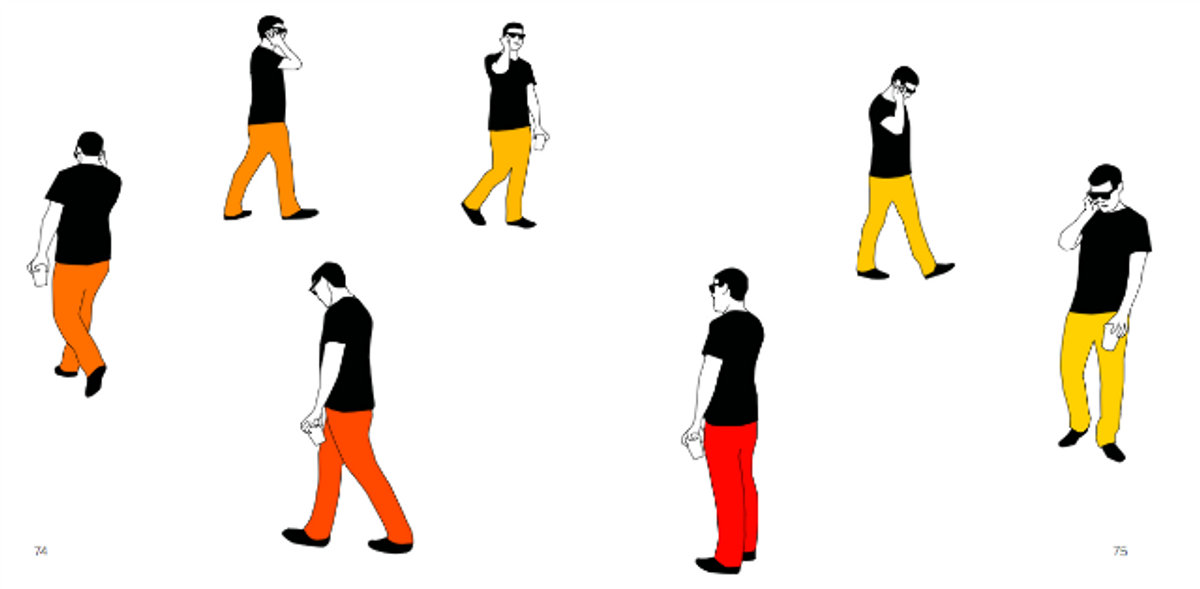
There’s a post (that I can no longer find, unfortunately) on the hilarious Tumblr Sexpigeon (SFW, I promise) that features a man on the street, slouching over his smartphone, face angled far down, features invisible. The caption, something to the effect of: “What a brave new world for posture we live in.” The advent of portable technology has brought with it a range of new behaviors, both virtual and physical. Two recent projects take on the IRL side of how we interface with our contemporary devices.

The Hip Bump from Curious Rituals
Curious Rituals is a research project by Nicolas Nova, Katherine Miyake, Nancy Kwon, and Walton Chiu that examines “gestural interaction in the digital everyday.” Their recent PDF publication of the same name explores the grammar of physical actions that we have invented to deal with technology. The project might sound abstract, but these are very real habits, ranging from “The iPad Photographer” — the strange, two-handed method we have of taking snapshots with iPads — to “The Security Pass Hip Bump” — the gesture of lifting a pants pocket or handbag that holds a security clearance card to a sensor in order to unlock a door.
More subtle gestures include the “Wake-Up Waggle,” tapping a computer’s keyboard and waving its mouse to wake it up, or the “iPhone Compass Callibrator,” that move of waving an iPhone in a figure-eight to orient its compass (can’t say this one has worked very well for me). “Cell Trance” refers to the daze that befalls us when walking while talking on a mobile phone: “To onlookers, the erratic perambulation looks aimless, as if the caller is detached from his surroundings, absorbed in a private sonic universe.”

Bag Swipe from Curious Rituals
The group’s study is a fascinating dive into the sociology of post-digital humanity. As technology becomes a larger part of our lives, it also becomes a bigger part of our bodies as well. Yet how we relate to our technology physically is a largely unexplored topic for most of us who adopt these actions out of subconscious convenience. Tell me you haven’t experienced the “lazy viewer” — the supine pose and horizontal orientation we take when using our laptops in bed — before. Here’s my addition: “Flip-flop,” referring to the annoyed reorientation of your iPhone while laying in bed when an app goes mistakenly horizontal.

Gabriele Meldaikyte’s “Multi-Touch Gesture” series (Images courtesy the artist)
Artist Gabriele Meldaikyte’s “Multi-Touch Gestures” series remakes the actions through which we interact with our smartphones. Meldaikyte turned five actions, flicking, pinching, tapping, swiping, and scrolling, into lo-fi, non-digital devices made of paper, plastic, and wood that mimic those gestures. The artist’s project shares something with Curious Rituals in that it seeks to document a certain strange subculture of movement. Her aim is to “perpetuate” these gestures so that “they become accessible for future generations,” who will no doubt have moved on in their digital-physical habits.
Meldaikyte’s pinch sculpture uses a plastic armature and a magnifying glass to mimic the resizing of text on a smartphone screen. In the scroll piece, a series of wooden wheels operated by rubber bands scroll a newspaper column. The simple, timeless nature of her sculptures (they look like something that might be shown in a museum a century or two hence) reinforces the idea that our technological innovations and the interactions that we consider new or avant-garde now are really anything but permanent.

Shares